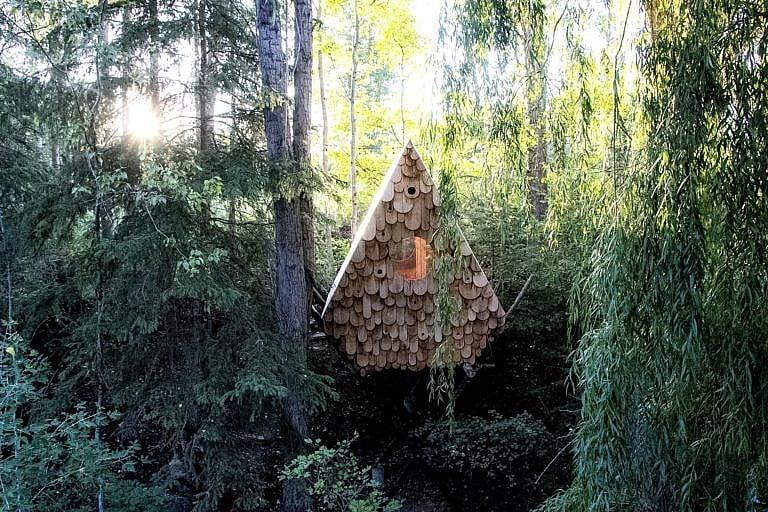This tiny B.C. hut is a birdhouse for humans
How one Calgary architect fulfilled his longtime dream to live among the birds

Share

Every summer when Mark Erickson was growing up, his family would drive three hours west of their home in Calgary through the mountainous wilderness of Banff to visit their spartan two-bedroom cottage in Windermere, B.C. The remote cabin is where he learned to fish, build tree forts in the forest, and most importantly, birdwatch. Erickson recalls spending hours sitting with his late grandfather on the front porch, learning how to identify birds by their calls. “As a kid I had all these fantasies about what it would be like to fly,” he says. To this day, he continues birding with his mother. “We’ll still discover birds we haven’t seen out there before, which is always pretty exciting.”
READ: Habitat: A mid-century sanctuary by Ontario’s Chandos Lake
Two decades on, Erickson’s avian fascination is as strong as ever—and, in 2016, he began to dream of a way to get closer to the bird world. Erickson, who’s a co-owner and principal of the firm Studio North in Calgary, designed a small space near the family cabin where he could sleep amid the canopy of the trees. The Bird Hut, completed in 2017, is a whimsical, human-scale birdhouse resting on wooden stilts 10 feet off the ground. (To reach the deck, he has to travel up an elevated stone path on a hill.)
At only 100 square feet, the hut has barely enough room to fit a king-sized mattress on the floor. However, the small footprint was strategic: any structure 100 square feet or under doesn’t require a building permit, which gave Erickson free rein to create a truly madcap, experimental structure.
The entire structure only cost $3,000. This is because Erickson repurposed materials from previous builds: the hut sits on a deck platform made from boards taken from the old deck on the main cabin, which Erickson and his dad rebuilt in 2016. The stilts are lodgepole pine trunks Erickson scavenged from nearby Crown land after a forest fire ripped through. The only materials he bought new were the polycarbonate roof and cedar shingles decorating the facade. He built the entire hut by hand, working every weekend over the course of two months.
While it’s just 150 feet away from his family’s cabin, the Bird Hut seems to exist in its own tranquil universe. It rests on a pair of X-shaped stilts, which give it a slight wobble that makes you feel like you’re walking onto a branch. “When you’re laying down, it feels like being rocked in a cradle,” he says. “It’s probably as close as you can get to being a bird without being a bird.”
READ: Habitat: This vintage Ontario home combines retro space-age glamour with 21st-century perks
The tree canopy is visible through the structure’s transparent polycarbonate roof. “When the leaves are rustling, there’s this pleasant dappling of shadows. You’re looking up at a colourful, moving mosaic,” he says. Erickson sleeps there, with his wife and two children—ages three and a half and one—for approximately three weeks out of the year. They have to visit the main cabin for the bathroom and running water, but he says it is more than worth the hassle to experience the magical feeling of sleeping among the trees. “You’re just kind of floating in space, which inevitably has an effect on your dreams,” he says.

In addition to being a birdhouse for humans, the hut has several nesting boxes intended for feathered creatures, hidden within the structure’s scalloped facade. The birdhouses are all different sizes to attract a variety of species. Songbirds prefer a smaller, cozier space, while larger birds like the pileated woodpecker requires a bit more room. Each box has a hinge on top, so Erickson and his family can peek inside to spy on the birds when they’re inside the hutch.
“When the Bird Hut was first built, it was the new kid on the block, and the birds were all super curious. I would sit there over the course of the day and see all sorts of birds going in, checking it out. I saw a pileated woodpecker go into the upper box and thought, ‘Wow, I designed that for him and it’s the one he chose to go see.’ ”
READ: Habitat: This sustainable Nova Scotia home is a coastal refuge
Lately, some unusual inhabitants have taken up residence in the boxes: flying squirrels. The creatures are nocturnal, but any time Erickson sleeps out in the hut, he can hear them scratching at night. “Sometimes we’ll peek in and get to see them sleeping there during the day.”
Erickson wishes more birds would make the Bird Hut their home—so far its primary inhabitants are the flying squirrels—and the boxes are removable so he can continue to experiment with creating other spaces, figuring out what works and what doesn’t. Every year, before closing up the cabin for the winter, Erickson fills each box with suet and birdseed in the hope it will entice more feathered friends to build a dwelling in the hut. “Hopefully, with time, it’ll be more and more inhabited by all the creatures of the forest,” he says. But in the end, it doesn’t matter who ends up using the boxes. “The cabin belongs to the wilderness more than it belongs to us,” he says.
“Every time I get to look in the boxes and see what’s been going on, it’s like visiting a friend and catching up. I get to discover something new every time I visit it,” he says. “It’s just really grown into the site. It feels like it belongs there now.”